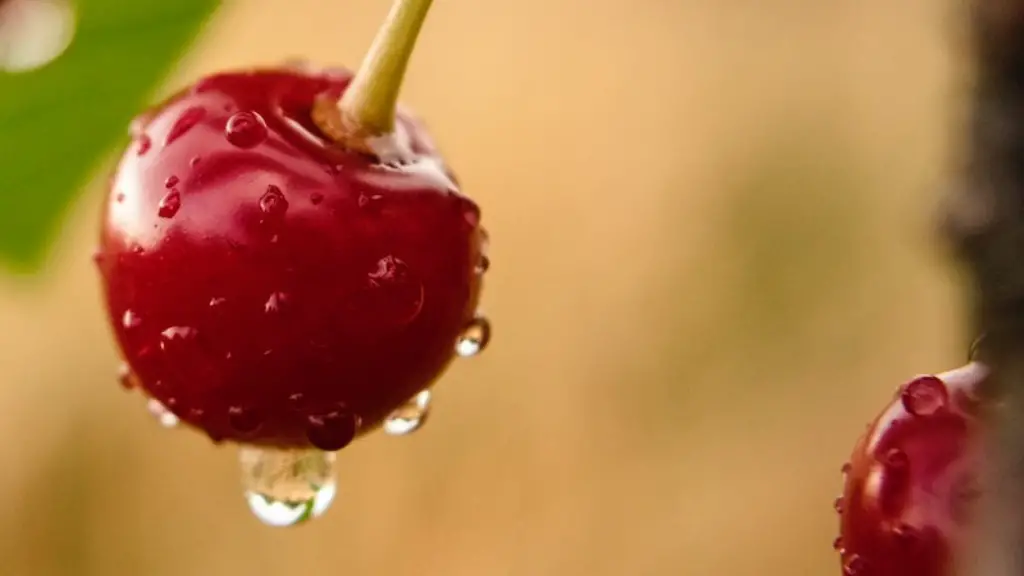Cherry trees, with their fragrant and beautiful blooms, may be one of the most popular ornamental trees. But can you grow cherry trees in a pot? As it turns out, you can, but it is an involved process that will require ongoing maintenance and upkeep.
The first step in successfully growing a cherry tree in a pot is ensuring the pot has adequate drainage. The soil should be amended with peat moss and then placed in the pot of adequate size. Depending on the size of the tree, the pot should at least be 20” wide, allowing for the roots to spread. Crockery or stones should be placed at the bottom for proper drainage.
Pruning is an important part of growing a cherry tree in a pot as it ensures lateral growth and avoids ultimate root entanglement. Pruning should be done twice a year, where you will cut off any dead or chipped branches as needed. An expert in arboriculture, Joanne Smith, states “Any branches that are crossed, growing toward the center, or otherwise competing should be removed. This will promote healthy, lateral growth when the tree is in the pot and the size should be controlled.”
Fertilization is also a critical element in the growth of ornamental cherry trees in a pot. Fertilize during the growing season using a formulation for blooming plants and then again in late fall to ensure a good healthy bloom come spring.
Light is of extreme importance, as cherry trees require strong light. To ensure proper growth, place the tree in the sunniest spot you can find, making sure it isn’t in a windy area. If there’s not much room, try to move the tree around to find the perfect spot. Remember, these trees often reach great heights, so keep that in mind when deciding where to place them.
Watering is also critical for the healthy growth of a cherry tree. Give the tree a deep, slow watering twice a week. Do not overwater and be sure to reference the humidity levels. Keep an eye on the soil inside the pot. If the soil has started to dry out, this means it’s time to add more water.
When winter comes, you will need to take precautions to protect your potted cherry tree. Try and cover the pot with burlap, as this will help keep temperatures consistent. Keep the tree in a warm, dry place to avoid frost damage and low temperatures. And finally, check the tree often to ensure it is free of any pests or disease.
Repotting
Repotting is an important part of growing a cherry tree in a pot. Cherry trees should be repotted every two to three years. Start by taking the tree out of its container and examining the roots. Any dead or damaged roots must be cut away, being careful not to disturb the healthy ones. You will then choose a larger pot and ensure that it has adequate drainage and an amended soil. Carefully place the new pot in place and begin filling it with amended soil. Lastly, you can begin pruning and fertilizing the tree.
Pest Control
Pest control is crucial for any potted tree, particularly ornamental cherry trees. This is especially true for those trees placed by a window as pests may be attracted to the area. It is important to note that these trees may be vulnerable to pests such as aphids, scale, and spider mites. One of the best remedies for pest control is to keep an eye on the tree and remove the pests by hand. If the problem persists, you may opt to use an organic pesticide.
Tips & Tricks
For those looking to successfully grow a cherry tree in a pot, there are a few tips and tricks that can help. For instance, you should check your tree for pests frequently and treat it Accordingly. Additionally, it is important to make sure the tree’s pot is placed in an area with ample light and kept out of cold, windy areas. Lastly, cherry trees may require re-potting every three years and heavy pruning twice a year to avoid overcrowding and entanglement of the roots.
Disease Control
Though the ornamental cherry tree is very resilient, it is still prone to diseases, such as root rot, powdery mildew and leaf spots. To avoid disease, it is important to provide the right kind of care and attention. First, you must ensure the tree has adequate water and sufficient drainage. You also should avoid wetting the leaves and canopy as much as possible. Lastly, regularly check the tree for any evidence of disease, such as patches of dead or discolored leaves, and act accordingly.


